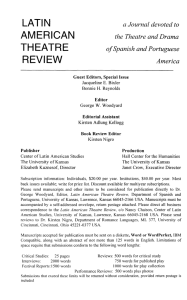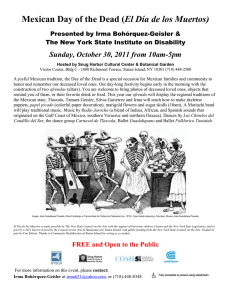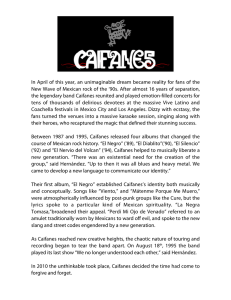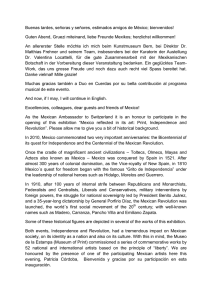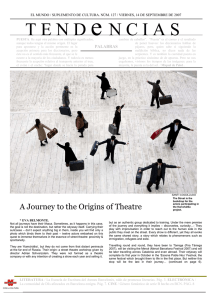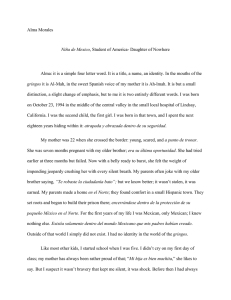Rodolfo Usigli`s Idea of Mexican Theatre
Anuncio
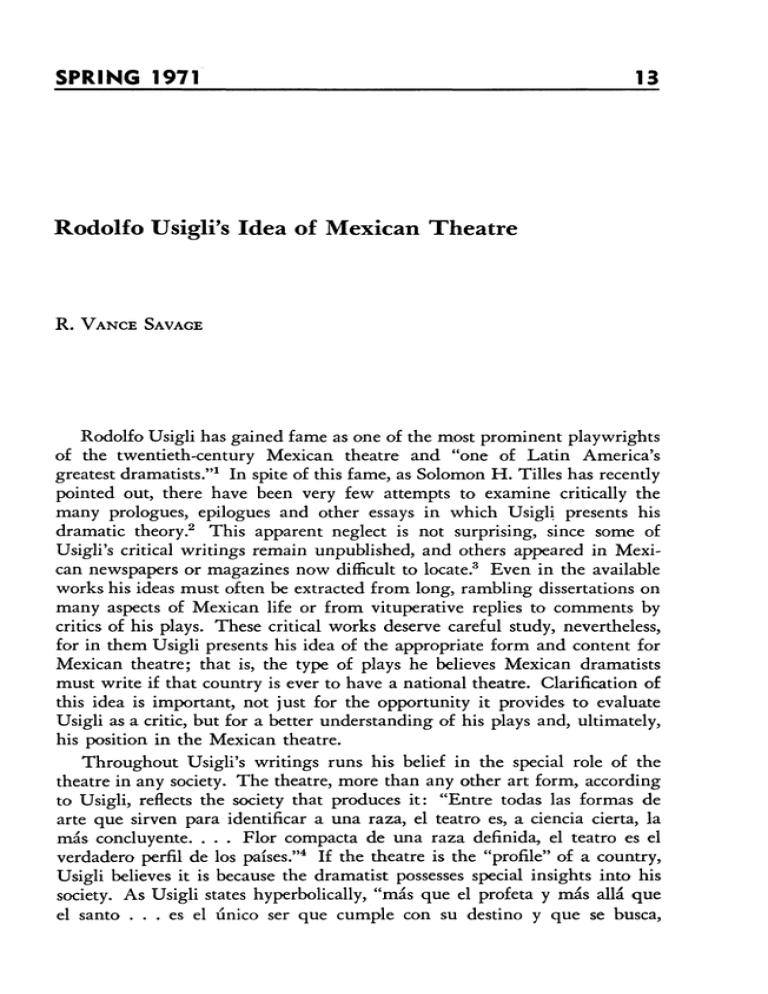
SPRING 1971 13 Rodolfo Usigli's Idea of Mexican Theatre R. VANCE SAVAGE Rodolfo Usigli has gained fame as one of the most prominent playwrights of the twentieth-century Mexican theatre and "one of Latin America's greatest dramatists."1 In spite of this fame, as Solomon H. Tilles has recendy pointed out, there have been very few attempts to examine critically the many prologues, epilogues and other essays in which Usigli presents his dramatic theory.2 This apparent neglect is not surprising, since some of Usigli's critical writings remain unpublished, and others appeared in Mexican newspapers or magazines now difficult to locate.3 Even in the available works his ideas must often be extracted from long, rambling dissertations on many aspects of Mexican life or from vituperative replies to comments by critics of his plays. These critical works deserve careful study, nevertheless, for in them Usigli presents his idea of the appropriate form and content for Mexican theatre; that is, the type of plays he believes Mexican dramatists must write if that country is ever to have a national theatre. Clarification of this idea is important, not just for the opportunity it provides to evaluate Usigli as a critic, but for a better understanding of his plays and, ultimately, his position in the Mexican theatre. Throughout Usigli's writings runs his belief in the special role of the theatre in any society. The theatre, more than any other art form, according to Usigli, reflects the society that produces it: "Entre todas las formas de arte que sirven para identificar a una raza, el teatro es, a ciencia cierta, la más concluyente. . . . Flor compacta de una raza definida, el teatro es el verdadero perfil de los países."4 If the theatre is the "profile" of a country, Usigli believes it is because the dramatist possesses special insights into his society. As Usigli states hyperbolically, "más que el profeta y más allá que el santo . . . es el único ser que cumple con su destino y que se busca, 14 LATIN AMERICAN THEATRE REVIEW viviseccionándose."5 Although other artists may have the same insights, they are not in the same position to interpret their findings for the average man. Unlike the novelist, poet or philosopher, who influence more select groups, the dramatist "se ve en la obligación de conducir multitudes impreparadas y no seleccionadas sobre las cuales debe regir él como gran unidad" ("Primeros apuntes," p. 191). His responsibility, then, is a serious one, for he is potentially the leader of the masses and must decide what is beneficial for them. This concept of the theatre is essentially social. The theatre serves to "abrir los ojos y para airear la conciencia del mundo." 6 The dramatist's role is one of public service, and the theatre he creates should serve as the conscience of society. Usigli admits that in formulating these ideas he was influenced chiefly by Shaw. He calls Heartbreak House the "punto de partida de mi conciencia del teatro."7 His comments on the purpose of the theatre are similar to those of Shaw, who, according to Barrett H. Clark, "both in theory and in practice . . . maintained that it is the function of the drama to teach and serve a practical and immediate purpose for the community and society."8 The idea of a theatre that reflects Mexican society distinguishes Usigli from the dramatists of most of the experimental groups in Mexico during the 1920s to 1940s. The authors of Ulises and Orientación, for example, emphasized the importance of the universality of the theatre. Usigli emphasizes the uniqueness of the theatre of each country: "El teatro de un país es siempre y sólo de ese país, y no importa mucho que sus obras se unlversalicen o no."9 As a result, Usigli's disillusionment with the experimental groups is stated often in his essays in the 1940s and 1950s. He accuses the experimentalists of making the mistake of considering the theatre an afición instead of a profession,10 of making the Mexican theatre an imitation of foreign works,11 and of writing for other writers instead of for the public.12 He concludes that imitating what he calls the "semidioses europeos," who were writing for select audiences in countries with long literary traditions, has been of little help in determining the proper form and content for a Mexican theatre. He insists that Mexican authors must treat the realities of Mexico if they are to write "Mexican" drama ("Ensayo," p. 290). Usigli believes that one way Mexican dramatists may help themselves to choose subjects that reflect Mexican society is to study the classical Greek theatre. In his long article on tragedy, "Primer ensayo hacia una tragedia mexicana,"13 Usigli attributes part of the success of the Greek dramatists to the fact that they were able to relate past traditions to present reality: "Importa como escribe Sófocles la tragedia, o como la escribe Esquilo, porque cada uno representa la reunión del pasado supervivo con el presente en acción de vivir. . . . La tradición—influencia religiosa, política e histórica—y el público contemporáneo—entidad social—exigen de modo general SPRING 1971 15 que el dramaturgo trate un tema histórico o mitológico nativo, conocido de los espectadores" (p. 107). According to Usigli, Mexican dramatists should emulate the Greeks and look to their religious, political and historical traditions for subject matter that will be meaningful to the contemporary Mexican public. One of the traditions that may be a source of valid dramatic material is the field of Mexican politics. In "Anatomía del teatro" Usigli supports this belief by citing Le malade imaginare, Act III, Scene 3, where Moliere's spokesman, Beraldo, defends bringing to the stage the different professions of men.14 Usigli concludes that whereas most societies have other "professions" for dramatic themes, in Mexico there is only one: "La profesión del político es en la vida, como en el teatro . . . la única profesión nacional" ("Anatomía," p. 290). In the unpublished prologue to Noche de estío,15 Usigli makes the same point by comparing Mexico to Spanish society during the Golden Age. Spanish dramatists of the time took their material from the court, from tradition, or from the professions. Although Mexico does not have a nobility to attract the dramatist's attention, it does have equally valid dramatic material: "Tenemos la política con todos sus repliegues, mezquindades, sombras pasajeras, grandezas, cómicas situaciones, ambiciones criminales y grotescas, la política, que, en realidad, ha substituido con ventaja a la nobleza por cuanto son ventajosos los señores políticos" (p. 143). Usigli points out that the writers of the satirical revistas have proved that political themes are valid subject matter for Mexican theatre ("Noche de estío," p. 143). It seems to him absurd to leave this material in the hands of such mediocre writers. Skilled writers of serious drama can use the same material and produce a much more meaningful theatre. In "Anatomía del teatro" he clarifies this point: "No hablo simplemente de un teatro político, en el que abundarían los temas satíricos y heroicos de la vida política, desde la espera en la antesala hasta la muerte por la sangre. El teatro es miedo a vivir si no contiene aquello que es universal para una raza o para un país o para un continente o para el mundo" (p. 10). Usigli emphasizes that he does not mean that politics constitute the only valid subject for a national theatre. A Mexican theatre must, however, have its roots in Mexican society, and since the national occupation is politics, "un teatro mexicano sin raíz política sería probablemente más difícil que hacer una revolución, o una dictadura, sin generales" ("Ensayo," p. 276). One of the aspects of Greek drama that Usigli considers most worthy of emulation is tragedy. He is especially concerned with recapturing the sense of tragedy, an element he considers lost in drama since classical antiquity. He believes that by examining the great classical tragedies, Mexican writers may extract that which is meaningful for Mexican drama. This concern for the tragic genre is evident throughout Usigli's critical LATIN AMERICAN THEATRE REVIEW 16 writings. As early as 1931 he was thinking of the possibility of Mexican tragedy: "Tenemos sin poder aprovecharlos correctamente, todos los elementos de la alta tragedia; todos los venenos que se embaten entre sí, un ideal para la revolución, un ideal para la paz y un ingenio robusto contra esos y otros ideales" ("Primeros apuntes," p. 197). Two years later Usigli began to think of Mexican politics as a source for tragic themes. He was tempted to try to write tragedies in his earliest political plays, but decided on comedies in the style of Moliere, Romains and Shaw ("Noche de estío," p. 2). He believed that Aristotle's concept of the type of man who should be the object of imitation would include Mexican politicians, as well as other types who were in positions of power in Mexico ("Noche de estío," p. 142). In 1937 Usigli put his idea into practice when he wrote El gesticulador, the work which he claims to be the first serious attempt at tragedy in the Mexican theatre.16 Seven years later he wrote his second tragedy, Corona de sombra, considered by many to be his best play. Usigli's continued interest in tragedy is best demonstrated by an essay written in 1950, "Primer ensayo hacia una tragedia mexicana." In this work he discusses tragedy in terms of Nietzsche's theory of the serene Apollonian elements and the chaotic Dionysian ones, which, in great drama, are blended artistically. After the period of the Greeks, the Apollonian aspects of tragedy seem to be replaced by the Dionysian drunkenness: "El espectador y el autor por parejo han conspirado durante siglos para extinguir en ellos y en sus descendientes, junto con otras virtudes externas, lo que Nietzsche llamaba el placer o el deleite de lo trágico. Uno y otro lo han reemplazado, subvenido o adulterado por el deleite o el placer de lo morboso, lo mismo en el aspecto sexual que en el aspecto sentimental" (p. 104). As one example of the failure of tragedians after the Greeks, Usigli cites Shakespeare, who comes close to capturing the sentiment and character of tragedy, but distorts the form. Usigli compares his plays to a painting by Picasso, with a leg protruding from the armpit or an eye shining from the stomach (p. 105). In this distortion Shakespeare somehow misses what Usigli calls the sense of tragedy, a term he defines only as "la medida del hombre" (p. 112). The failure of modern dramatists to capture the sense of tragedy seems to Usigli to be best illustrated by the works of Eugene O'Neill. O'Neill also emphasizes the Dionysian aspects and neglects the Apollonian serenity: "O'Neill posee el sentimiento pero no la proporción de lo trágico, ni su sentido más profundo. Su obra suscita el terror o el horror, pero no la piedad" (p. 111). In Mourning Becomes Electra O'Neill makes another mistake typical of many modern dramatists; instead of searching out the tragic elements in his own society, he attempts to borrow themes from the Greeks. The result is that "la transposición del tema lo hace caerse de falso" (P. ni). Modern dramatists, concludes Usigli, have failed to capture the spirit of SPRING 1971 17 tragedy. Because of their obsession with the grotesque elements, they have failed to achieve the harmonious combination of the grotesque and the serene of the Greek classical theatre. Also, they have neglected to search out the tragic elements in their own society, and instead have made poor copies of classical tragedy. In order to avoid these errors, Usigli insists that Mexican authors study Mexican society. Then, by using Greek tragedy as a model, they may adapt contemporary content to a modern form, which will enable them to recapture some of the spirit of tragedy which was present in Greek drama. Usigli supports his theory by providing a concrete example of appropriate material from Mexican history. He sees in Cuauhtemoc, the last of the Aztec emperors, the potential for revival of the tragic genre in Mexico: "Es particularmente este héroe—Cuauhtemoc—, es particularmente esta mezcla de una profecía antigua con una realidad moderna . . . lo que me mueve a pensar que en México, de todo el Continente, es donde existe la posibilidad de recrear la tragedia como género" (p. 125). Ten years later Usigli put his theory into practice by writing a tragedy in verse, complete with choruses, about the Aztec chief. Corona de juego, like El gesticulador and Corona de sombra, demonstrates Usigli's desire to add grandeur to the Mexican theatre by creating a Mexican tragedy. There is one other significant element in Usigli's ideal Mexican theatre. Having outlined the purpose of the theatre, appropriate subject matter and the need to search for tragic elements in Mexican society, there remains the question of an appropriate style that will enable Mexican dramatists to express their ideas. Moreover, if a national theatre is to have the support of the Mexican public, what is the form that will appeal to that public? Usigli observes that the example which has existed for some twenty-five years in the revista has been ignored by Mexican dramatists. The revista gives the Mexican a realistic portrayal of the elements of Mexican society which are familiar to all Mexicans. In this sense, a national theatre should emulate the revista: "Hay que hacer algo por este mexicano que espía incómodamente su propia vida en los demás por el ojo de una cerradura. Hay que acercarle un sillón confortable, invitarlo a sentarse, apagar la luz en torno a él y encenderla sobre su imagen reflejada en otro."17 Because he finds that the realistic technique imposes certain limitations, Usigli personally prefers a more poetic theatre: "El teatro realista es deleznable, si no malo, por cuanto depende de un sistema de circunstancias externas, de movimiento dirigidos hacia un objeto inmediato, de acciones sujetas al denominador común de una fecha y a relaciones habitualmente objetivas, de familia y de clase."18 Furthermore, the realistic theatre tends to become bogged down in trivial, ephemeral themes: "No es sólo la filtración de impurezas y de vulgaridad en los personajes; la banalidad y la repetición. . . . Es—la vida privada de sus seres, el aislamiento de sus esce- 18 LATIN AMERICAN THEATRE REVIEW narios, la intimidad, a menudo desnuda en su aspecto sexual; el módico egoísmo de sus sentimientos; la falta de alcance de sus catástrofes; lo domestico de la vida; lo intrascendente de sus pasiones, la pequenez de su radio de acción" ("Noche de estío," p. 139). The appearance of Pirandello indicates to Usigli a protest against the limitations of realistic drama. He hopes that Pirandello, and other playwrights like Lorca, Cocteau and Giraudoux, will cause the return of poetry to the theatre ("Noche de estío," p. 139). Usigli insists, however, that "mientras México no posea su propio teatro realista, las obras poéticas serán accidentes individuales, fechas para las historias de la literatura; pero no constituirán un teatro poético propio" ("Discurso," p. 334). He believes, therefore, that social realism is the style to be preferred, although he envisions a gradual transition to a more poetic drama as public taste becomes more refined. In formulating his idea of a Mexican theatre, Usigli is essentially an eclectic. He selects concepts from other writers, past and present, which he feels apply to Mexican drama. He derives his theory of the purpose of the theatre from Shaw; he looks to the classical Greeks, the Spanish Golden Age, diverse writers such as Moliere, and to Mexican traditions to find meaningful subject matter; and he borrows Nietzsche's terminology to explain how modern dramatists can capture the spirit of tragedy in modern society. His originality lies in the selection and application of these ideas to the Mexican theatre. Although Usigli's theoretical ideas are taken principally from writers of the past, they also demonstrate his involvement with contemporary trends in Mexico and other countries. The insistence on Mexican subject matter represents a rejection of the experimentalists' "universal" works. On the other hand, his advocacy of political themes shows his agreement with the ideas of the authors of the Teatro de Ahora (1932) and with the prevalent trend on the stages of the United States. As Bamber Gascoigne points out, the "1930s stand out from the whole history of the theatre as the decade of political theatre."19 Since Usigli spent 1935 studying drama at Yale, it is safe to assume that he was cognizant of this trend. Usigli's desire for a tragic and poetic theatre also reflects contemporary dramatic thought. During the period he was formulating and recording his theoretical ideas, leading American and European playwrights, such as O'Neill, Lorca and Eliot, were experimenting with forms of modern tragedy, and many dramatists were attempting to achieve poetic effects in their plays. Authors such as Lorca and Eliot were experimenting with varied rhymes and rhythms. Other dramatists, such as O'Casey, were achieving poetic effect through rhythmic prose. Usigli knew modern drama well; it is understandable that he should share his contemporaries' enthusiasm for tragic and poetic drama. Usigli's essays show his special concern for the role of the public. He SPRING 1971 19 envisions the theatre as a means of educating the public, but he also insists on subject matter that will be received well by a Mexican audience. He provides specific examples for some of the proper subjects for Mexican plays, such as the world of politics, and indicates how dramatists may look for other valid dramatic material in their society. The most confusing part of these critical ideas is the discussion of tragedy. Usigli's definition of the tragic sense as simply "la medida del hombre" is, at best, hazy. His adoption of Nietzsche's theory, which, as Nietzsche recognizes, is itself mystic and vague, does not help to clarify his meaning.20 Also, Usigli's judgments of all tragedians since the Greeks seem excessively harsh. Although his disappointment with O'Neill's Mourning Becomes Electra (1931) is generally shared by other critics,21 O'Neill's earlier work, Desire Under the Elms (1924), is considered by some to be one of the most successful attempts at modern tragedy.22 Usigli's criticism of Shakespeare's freedom of form also seems unjustified, since Usigli himself recommends that dramatists should search out modern material, which may require modern form. Usigli's idea of a Mexican theatre may be summarized as one modeled on the European realistic tradition, but treating meaningful national themes. Although this idea does not constitute a complete dramatic theory which describes a theatre that would be uniquely Mexican in form and content, it does offer flexible guidelines for plays of some significance and grandeur that, hopefully, will attract the Mexican public to the theatre. Once they have their audience, Mexican dramatists can move toward the poetic theatre that Usigli believes will be "la más grande hazaña del espíritu nativo" ("Discurso," p. 334). Lewis and Clar\ College Notes 1. Willis Knapp Jones, Behind Spanish American Footlights (Austin: University of Texas Press, 1966), p. 502. 2. "Rodolfo Usigli's Concept of Dramatic Art," Latin American Theatre Review, 3/2 (Spring 1970), pp. 31-38. There is one detailed study of Usigli's dramatic theory: D. L. Rosenberg, in "The Dramatic Theory of Rodolfo Usigli: The Poetry of Selective Realism," unpublished Ph.D. dissertation, State University of Iowa, 1962, evaluates Usigli's basic theoretical ideas, emphasizing his approach to realism. Although Rosenberg does not relate Usigli's theory to the Mexican theatre, his organization of Usigli's major ideas is useful. Also see my study, "The 'Mexican' Theater of Rodolfo Usigli: Theory and Practice," unpublished Ph.D. dissertation, University of Oregon, 1969. 3. Ten of Usigli's prologues, epilogues or other essays (one of which—the prologue to Un día de estos . . . —numbers 151 pages) remain unpublished. In 1964 Fondo de Cultura Económica had the complete collection of manuscripts of Usigli's essays but decided not to publish them. 4. "Primeros apuntes sobre el teatro," México en el teatro (Mexico: Imprenta Mundial, 1932), p. 197. This is a collection of five articles originally published in El Universal Ilustrado (Mexico), Sept. 10 and 24, Oct. 1 and 22, Nov. 5, 1931. 5. "Poeta en libertad," Cuadernos Americanos, XLIX (Jan.-Feb., 1950), p. 297. 6. "Un día de estos," unpublished prologue, 1953, p. 5. 20 LATIN AMERICAN THEATRE REVIEW 7. "Dos conversaciones con George Bernard Shaw y algunas cartas," Cuadei-nos Americanos, Part II, XXXI (Jan.-Feb., 1947), p. 238. 8. European Theories of the Drama (New York: Crown Publishers, 1918), p. 471. 9. "El teatro en lucha," Hoy (Mexico City), No. 335 (July 24, 1943), p. 61. 10. "Addenda después del estreno," Jano es una muchacha (Mexico: Imprenta Nuevo Mundo, 1952), pp. 188-189. 11. "El gran teatro del nuevo mundo," unpublished prologue to Los fugitivos, 1950, p. 24. 12. "Ensayo sobre la actualidad de la poesía dramática," in El gesticulador (Mexico: Editorial Stylo, 1947), p. 290. Subsequent references appear in the text as "Ensayo." 13. "Primer ensayo hacia una tragedia mexicana," Cuadernos Americanos, LII (JulyAugust, 1950). Subsequent references appear as "Primer ensayo." 14. "Anatomía del teatro," El Nacional (Mexico City), April 20, 1947, p. 10. Subsequent references appear in the text as "Anatomía." 15. "Prólogo a Noche de estío," unpublished, 1935. Subsequent references appear in the text as "Noche de estío." 16. See "Doce notas," in El gesticulador (Mexico: Editorial Stylo, 1947), p. 241. 17. "Anatomía del teatro," April 13, 1947, p. 6. 18. "Discurso por un teatro realista," América, 1937, pp. 316-317. Subsequent references appear in the text as "Discurso." 19. Bamber Gascoigne, Twentieth Century Drama (New York: Barnes and Noble, Inc., 1962), p. 26. 20. See Otto Manthey-Zorn, Dionysus: The Tragedy of Nietzsche (Amherst: Amherst College Press, 1956), p. 28. 21. Gascoigne, p. 115, is of the opinion that O'Neill only succeeded in belittling his archetypes. 22. See Gascoigne, p. 91; Herbert J. Muller, The Spirit of Tragedy (New York: Alfred A. Knopf, 1956), p. 315.

